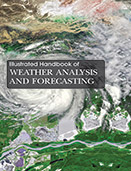Earth and Environmental Science

Weather forecasting is considered as the most challenging problem witnessed by the world in the last decade. This indirectly had an impact on effective prediction of the weather data. Due to the latest technological updates, the capabilities of retrieving and storing has increased; resulting in the availability of massive meteorology data in different formats.
Illustrated Handbook of Weather Analysis and Forecasting contains a wealth of information on real-life techniques, methods, and forecast systems. With the increase in the number of weather stations, huge amount of data is available on daily, weekly, monthly and yearly basis and the data is stored exponentially. In the last decade, with the advancements in science and technology, both empirical and dynamical approaches were developed for the prediction of weather. Most of the meteorologists have made significant strides in forecasting the weather using models based on time series. However, to analyze the related data from this massive data, mining techniques play a vital role. To have an effective prediction; it is needed to identify the correlation between the attributes of weather, which indirectly have a role in the weather changes.
Hence, This Illustrated Handbook of Weather Analysis and Forecasting proposes for effective weather prediction by considering various attributes together with their correlations together with data mining techniques.
Knowledge of meteorology forms the basis of scientific weather forecasting, which revolves around predicting the state of the atmosphere for a given location. Weather forecasting as practiced by humans is an example of having to make judgments in the presence of uncertainty. Weather forecasts are often made by collecting quantitative data about the current state of the atmosphere and using scientific understanding of atmospheric processes to project how the atmosphere will evolve in future. Over the last few years the necessity of increasing knowledge about the cognitive process in weather forecasting has been recognized. This book is essential guide to the history, current trends, and the future of meteorology.